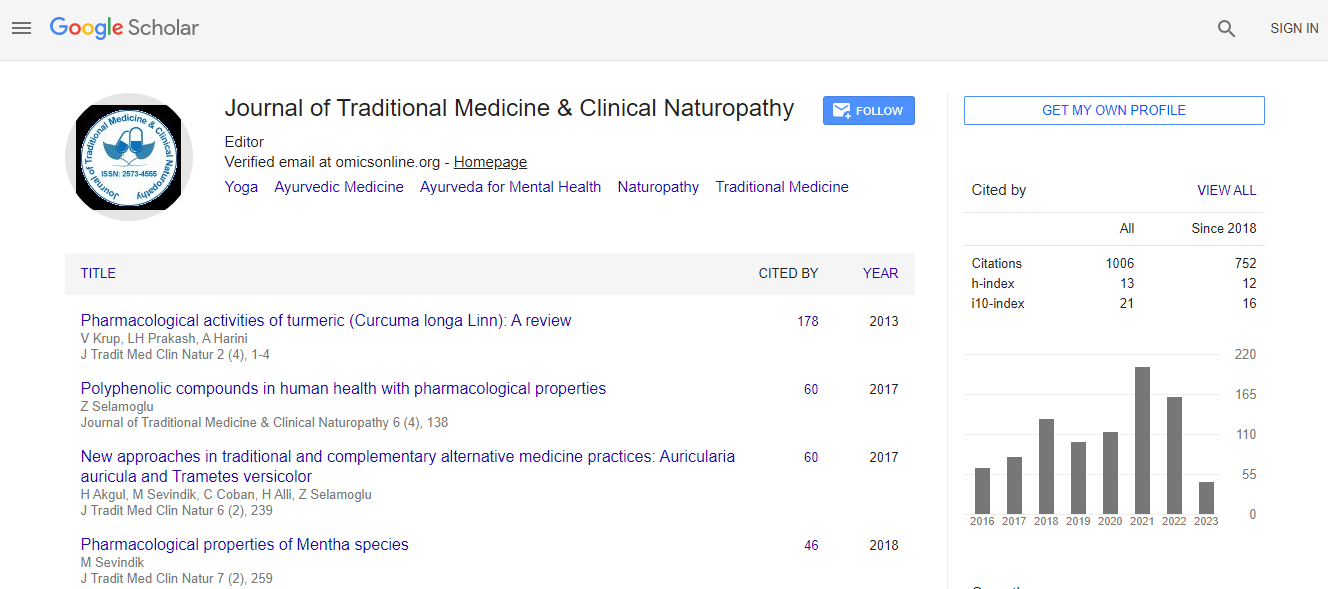Our Group organises 3000+ Global Conferenceseries Events every year across USA, Europe & Asia with support from 1000 more scientific Societies and Publishes 700+ Open Access Journals which contains over 50000 eminent personalities, reputed scientists as editorial board members.
Open Access Journals gaining more Readers and Citations
700 Journals and 15,000,000 Readers Each Journal is getting 25,000+ Readers
Google Scholar citation report
Citations : 1504
Journal of Traditional Medicine & Clinical Naturopathy peer review process verified at publons
Indexed In
- CAS Source Index (CASSI)
- Google Scholar
- Sherpa Romeo
- Open J Gate
- Genamics JournalSeek
- RefSeek
- Directory of Research Journal Indexing (DRJI)
- Hamdard University
- EBSCO A-Z
- Publons
- Geneva Foundation for Medical Education and Research
- Euro Pub
- ICMJE
Useful Links
Recommended Journals
Related Subjects
Share This Page
Prescription patterns of Chinese herbal products for patients with fractures in Taiwan: A nationwide population-based study
6th International Conference and Exhibition on Traditional & Alternative Medicine
Mao-Feng Sun
China Medical University Hospital, Taiwan
ScientificTracks Abstracts: J Tradi Med Clin Natur
Abstract
Ethno Pharmacological Relevance: Traditional Chinese Medicine (TCM) has been used in the treatment of fracture for thousands of years. However, large-scale surveys examining the utilization of Chinese herbal products (CHPs) for treating fractures and their related symptoms are lacking. Aim: This study aimed to investigate the prescription patterns of CHPs among patients with fractures in Taiwan. Materials & Methods: The TCM usage in patients with fractures was analyzed using a sample of one million individuals randomly selected from the National Health Insurance Research Database who were newly diagnosis with fractures in 2001-2008, with a followed-up period through 2010. Results: We identified 115,327 patients who were newly diagnosed with fractures in the study population. Among them, 4.97% (n<5731) adjunctively utilized the TCM for fracture treatment. TCM users were mostly young or middle-aged, female, and resided in highly urbanized areas. With regard to the comorbidities of fractures, TCM users had a lower prevalence of coronary artery disease, chronic obstructive lung disease, diabetes mellitus, hypertension and stroke than non-TCM users, except for osteoporosis. Shu-jing-huo-xue-tang was the most frequently prescribed Chinese herbal formula, while Rhizoma Drynariae (Gu-sui-bu) was the most common single herb for patients with fractures. The CHPs were found to cover not only bone healing but also fracture-related symptoms. TCM users had lower medical expenditure for hospitalization for the first six months after incident fractures than non- TCM users (1749�±72650 versus 2274�±73159 US dollars, p<0.0001). Conclusions: Our study identified the TCM utilization for patients with fractures in Taiwan. Integration of TCM treatment reduced the medical costs for hospitalization. Further basic research and clinical studies to investigate the mechanism and clinical efficacies of CHPs are warranted.Biography
Mao-Feng Sun is a Chairman and Director, Professor at School of Chinese Medicine, China Medical University & Vice-Superintendent of China Medical University Hospital. His specialty is Acupuncture and Chinese Medicine. The World Peace Foundation of United Nations NGO and the Organizing Committee of 21st Century Congress of Natural Medicine had presented him with a World Famous Doctor Award to commend his outstanding contribution made to the development of World Natural Medicine.
Email: maofeng@mail.cmuh.org.tw

 Spanish
Spanish  Chinese
Chinese  Russian
Russian  German
German  French
French  Japanese
Japanese  Portuguese
Portuguese  Hindi
Hindi 
